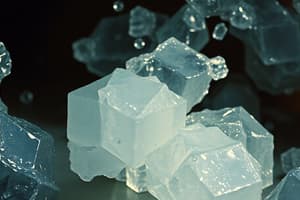Podcast
Questions and Answers
What is a screw dislocation?
What is a screw dislocation?
- An imperfection related to oxygen vacancies
- An intentional introduction of point defects
- A line imperfection where a partial slip has occurred across the crystal plane (correct)
- A surface defect near the crystal plane
How do surface defects like steps and kinks influence material properties?
How do surface defects like steps and kinks influence material properties?
- By enhancing mechanical strength (correct)
- By increasing defect density
- By improving electrical conductivity
- By reducing reactivity
What type of imperfection occurs at single lattice points in crystalline materials?
What type of imperfection occurs at single lattice points in crystalline materials?
- Impurity atoms
- Interstitials
- Vacancies (correct)
- Line defects
What unique advantages can imperfections in solids offer?
What unique advantages can imperfections in solids offer?
Which type of imperfection involves an extra ion residing between regular atomic sites, causing strain and stress in the material?
Which type of imperfection involves an extra ion residing between regular atomic sites, causing strain and stress in the material?
How do dopants used to create semiconductors affect electrical conductivity?
How do dopants used to create semiconductors affect electrical conductivity?
In a Schottky defect, what happens to create an empty space in the crystal lattice?
In a Schottky defect, what happens to create an empty space in the crystal lattice?
What role do high-temperature superconductors play in utilizing imperfections like oxygen vacancies?
What role do high-temperature superconductors play in utilizing imperfections like oxygen vacancies?
What causes a distortion in the crystal lattice around a vacant Cl⁻ position in sodium chloride (NaCl)?
What causes a distortion in the crystal lattice around a vacant Cl⁻ position in sodium chloride (NaCl)?
How do imperfections like grain boundaries impact the development of lithium batteries?
How do imperfections like grain boundaries impact the development of lithium batteries?
Which type of defect is characterized by kinks or breaks along straight lines connecting multiple lattice points?
Which type of defect is characterized by kinks or breaks along straight lines connecting multiple lattice points?
What type of defect includes impurity atoms like carbon in diamond?
What type of defect includes impurity atoms like carbon in diamond?
Study Notes
Exploring Solid State Chemistry through Imperfections in Crystalline Materials
In solid state chemistry, we delve into the world of matter where atoms, molecules, and ions arrange themselves into orderly structures known as crystals. However, this seemingly perfect arrangement is often disrupted by defects and irregularities called imperfections. These intriguing flaws hold significant importance, offering valuable insights into materials' behavior while also shaping their properties.
There exist three primary types of imperfections within crystalline lattices:
-
Point defects — Occurring at single lattice points, these can be further divided into vacancies (missing atom) and interstitials (extra atom occupying an unusual site).
-
Vacancy (or Schottky defect): An empty space created when a cation and anion in adjacent positions both move away from each other.
- For example, sodium chloride (NaCl) has Na⁺ cations and Cl⁻ anions alternating in a face-centered cubic lattice. A vacant Cl⁻ position causes a distortion around it due to the loss of electrons, leading to altered bond lengths with neighboring ions.
-
Interstitial: An extra ion residing in a location between regular atomic sites, creating strain and stress in the material; common examples include impurity atoms like carbon in diamond.
-
-
Line defects: Kinks or breaks present along straight lines connecting multiple lattice points, typically caused during crystal growth. Examples include screw dislocations—a line imperfection where a partial slip has occurred across the entire width of the crystal plane.
-
Surface defects: Flaws located near the surface, such as steps and kinks; they influence material properties like reactivity and mechanical strength.
These flaws may appear undesirable initially, yet they offer unique advantages. For instance, dopants used to create semiconductors intentionally introduce point defects, altering electrical conductivity, thereby enhancing circuitry performance. Similarly, high-temperature superconductors rely upon unconventional copper oxides containing oxygen vacancies.
Moreover, understanding and controlling these imperfections can lead to improvements in various applications, including:
- Improved battery technology: By reducing defect density, energy storage devices could experience longer lifetimes and higher capacities.
- Enhanced photovoltaic efficiency: Controlling light trapping in solar cells depends largely on modifying the distribution of imperfections.
- Developing better lithium batteries: Understanding the effects of grain boundaries (line defects) on electrochemical reactions would enable scientists to design enhanced battery technologies.
Imperfections serve as one of the key components driving progress in modern solid-state chemistry, providing researchers with the opportunity to explore new potential applications and expand our knowledge base.
Studying That Suits You
Use AI to generate personalized quizzes and flashcards to suit your learning preferences.
Description
Test your knowledge on imperfections in crystalline materials, exploring point defects, line defects, and surface defects in solid state chemistry. Learn about vacancies, interstitials, screw dislocations, and their impact on material properties and applications.



